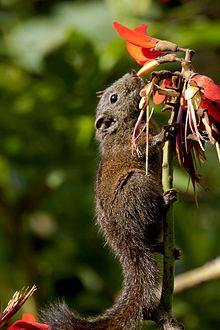Nilgiri striped squirrel
| Nilgiri striped squirrel | |
|---|---|

| |
| Scientific classification | |
| Domain: | Eukaryota |
| Kingdom: | Animalia |
| Phylum: | Chordata |
| Class: | Mammalia |
| Order: | Rodentia |
| Family: | Sciuridae |
| Genus: | Funambulus |
| Species: | F. sublineatus
|
| Binomial name | |
| Funambulus sublineatus (Waterhouse, 1838)
| |
| Subspecies[2] | |
|
See text | |
| Synonyms | |
|
Sciurus delesserti Gervais, 1841 | |
The Nilgiri striped squirrel (Funambulus sublineatus) is a threatened species of rodent, a small squirrel (Sciuridae) from rainforests in the southern Western Ghats, including the Nilgiris, in Peninsular India. It formerly included Funambulus obscurus from Sri Lanka as a subspecies, at which point the English name of the "combined species" also was dusky striped squirrel (a name now restricted to the Sri Lankan species).
Taxonomy
Funambulus sublineatus was scientifically described in 1838.[3] Later it was merged with the Sri Lankan obscurus, then regarded as a subspecies of Funambulus sublineatus. In 2012, a review found that the two were highly distinct and recommended that they should be recognized as separate species.[4]
Distribution
The former range of the species, before the taxonomic split, was in both India and Sri Lanka, though the Nilgiri palm squirrel (F. sublineatus) is now restricted in distribution to the Western Ghats of India.[5] Very little is known of this squirrel, probably the smallest in the genus weighing about 40g. Its new status as an endemic mammal to India means records need updating.
The species is confined to wet humid forests either in the Western Ghats and Nilgiri hills (and surrounding areas such as around Kodaikanal in India)
References
- ^ Middleton, K.; Ferguson, A. (2020). "Funambulus sublineatus". IUCN Red List of Threatened Species. 2020: e.T88813572A22259638. doi:10.2305/IUCN.UK.2020-2.RLTS.T88813572A22259638.en. Retrieved 17 November 2021.
- ^ Thorington, R.W. Jr.; Hoffmann, R.S. (2005). "Family Sciuridae". In Wilson, D.E.; Reeder, D.M (eds.). Mammal Species of the World: a taxonomic and geographic reference (3rd ed.). The Johns Hopkins University Press. pp. 754–818. ISBN 0-8018-8221-4. OCLC 26158608.
- ^ Grigg, H.B. (1880). A Manual of the Nilagiri District in the Madras Presidency. Madras: Government Press.
- ^ Rajith Dissanayake. 2012. The Nilgiri striped squirrel (Funambulus sublineatus), and the dusky striped squirrel (Funambulus obscurus), two additions to the endemic mammal fauna of India and Sri Lanka. Archived 2016-03-13 at the Wayback Machine Small Mammal Mail. Vol 3(2):6-7
- ^ Dissanayake, Rajith; Oshida, Tatsuo (2012). "The systematics of the dusky striped squirrel, Funambulus sublineatus (Waterhouse, 1838) (Rodentia: Sciuridae) and its relationships to Layard's squirrel, Funambulus layardi Blyth, 1849". Journal of Natural History. 46 (1–2): 91–116. doi:10.1080/00222933.2011.626126. S2CID 85140298.

